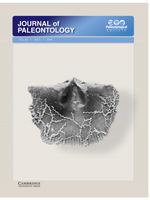Clusters of associated colony fragments discovered weathering out of bedding planes in the Upper Ordovician of the Cincinnati, Ohio, region provide a rare opportunity to quantify intracolony variation in ramose stenolaemate bryozoans. Sixteen colonies were reassembled as completely as possible from 198 fragments, and the following colony-level characters were measured: colony dimensions, branch link length and diameter, and branch order. Results indicate that branch link length and diameter systematically decrease as colonies grow via branch bifurcation. Branching ratio (i.e., the number of distal first-order branches divided by the number of immediately proximal second-order branches) appears to be more genetically than environmentally controlled and to be consistent among orders of stenolaemates and perhaps across the phylum. Colonies with endozones mined out by endoskeletozoans result in broken branches as opposed to pristine growing tips. This varies stratigraphically, perhaps in response to the distribution of the boring animals. The rarity of borers and the systematic proximal increase in branch diameter in these colonies suggest the zooids in the proximal portions of the colonies were alive at the time of colony death. If the time and effort can be invested in reassembling colonies, these morphometric data can then be applied to taxonomic, phylogenetic, and paleoenvironmental studies.
How to translate text using browser tools
1 May 2016
Intracolony variation in colony morphology in reassembled fossil ramose stenolaemate bryozoans from the Upper Ordovician (Katian) of the Cincinnati Arch region, USA
Marcus M. Key, Jr.,
Patrick N. Wyse Jackson,
Stephen H. Felton
ACCESS THE FULL ARTICLE

Journal of Paleontology
Vol. 90 • No. 3
May 2016
Vol. 90 • No. 3
May 2016




